- Building an offshore team in India delivers exceptional value with 1.5 million engineers graduating annually, offering 50-70% cost savings compared to Western countries plus time zone advantages for near 24/7 development cycles.
- Four offshore models available: Dedicated Team, Offshore Development Center (ODC), Project-Based, and Hybrid Model.
- Setup process involves 7 key steps: Define goals, choose model, select partner, recruit talent, establish collaboration tools with time overlap, onboard culturally, and monitor performance.
- Critical compliance requirements: Valid employment contracts, 12% Provident Fund contributions, ESI for eligible employees, income tax withholding (TDS), gratuity after 5 years, state registration, and proper structuring to avoid Permanent Establishment tax risks.
Need help with setting up an offshore team in India? Contact Us Today!
Discover how Wisemonk creates impactful and reliable content.
Building an offshore team in India means hiring and managing skilled professionals in India who work as an extension of your company. Many global businesses struggle with high development costs, slow hiring cycles, and limited access to top talent in their home markets. This guide will explain why India is the leading destination, what models you can choose, the compliance factors you must know, and how to set up, and scale your offshore team successfully.
Why should you set up an offshore team in India?[toc=Why India is Ideal Destination]
If you’re a global business looking to build your offshore team in India, the biggest reasons are access to a massive pool of skilled developers, significant cost savings, and the ability to accelerate project timelines without compromising quality. India has become the global hub for offshore software development because it offers both scale and depth of talent at competitive rates.
From our experience helping companies worldwide, here’s why India stands out:
- Global talent pool at scale: India produces over 1.5 million engineers annually (AICTE, 2024), giving businesses an unmatched choice of skilled developers, project managers, and dedicated teams for software development projects.
- Cost efficiency without compromise: Development costs in India are 50–70% lower compared to Western countries, while maintaining high-quality outputs through specialized offshore development centers.
- Mature offshore ecosystem: Thousands of offshore development companies and dedicated offshore development centers (ODCs) operate in India, offering everything from software development services to stringent security protocols for global businesses.
- Time zone advantage: With a 9–12 hour difference from North America and Europe, your offshore team in India can extend project progress into a near 24/7 cycle, reducing technical debt and accelerating project timelines.
- Proven offshore success stories: Companies like Microsoft, Google, and countless startups have already built dedicated offshore teams in India, leveraging the country’s cost-effective solutions and competitive advantage.
💡 Expert Insight: According to Deloitte’s Global Outsourcing Survey, 59% of businesses outsource to cut costs, and India consistently ranks as the top offshore development destination thanks to its skilled workforce and cost effectiveness.
What models can you choose for building an offshore team?[toc=Offshore Models]
When you set up an offshore team in India, you don’t have to stick to one fixed model. Businesses can choose from different approaches depending on how much control, flexibility, and investment they want. Here are the most common models:
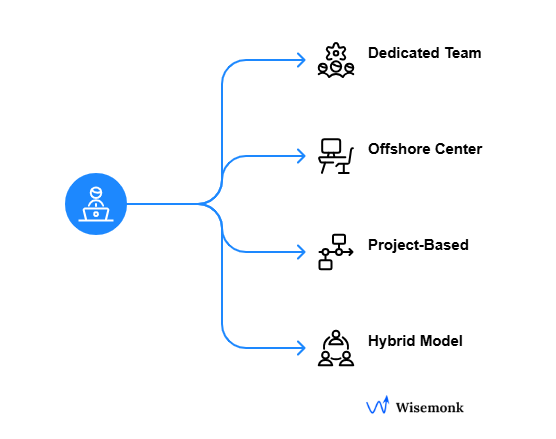
1. Dedicated Offshore Development Team
- You hire a team of offshore developers who work exclusively for your company.
- Ideal for long-term software development projects where continuity, control, and domain knowledge matter.
- Offers cost efficiency and access to a skilled, dedicated development team without the overhead of local hiring.
2. Offshore Development Center (ODC)
- A step beyond dedicated teams, this is like setting up a remote offshore team that functions as your extended office.
- Best for companies planning to scale, manage multiple development projects, or handle sensitive business processes under stringent security protocols.
- Provides more integration with your onshore team and ensures seamless collaboration.
3. Project-Based Outsourcing
- You partner with the right offshore development company to execute specific projects.
- Works well if you have short-term goals, limited timelines, or need to test the waters before investing in a full-scale offshore team.
- Suitable for businesses looking for cost effective solutions to manage peak workloads without long-term commitments.
4. Hybrid Model (Onshore and Offshore Teams)
- Combines the strengths of your onshore team with a dedicated offshore team in India.
- Onshore handles strategy, client communication, and business goals, while the offshore team accelerates execution, keeping development costs low.
- This model helps bridge cultural differences and manage offshore teams effectively while maintaining control over project timelines.
The “best” model depends on your company’s size, project complexity, and long-term goals. Whether you want flexibility, scale, or deep integration, India offers offshore models that fit every stage of growth.
How to set up an offshore team in India?[toc=How to Set Up]
To build your offshore team in India, you need a structured approach: define goals, choose the right model, pick a trusted partner, and set up strong processes for collaboration. A clear roadmap ensures you avoid compliance headaches and get your offshore software development team up and running smoothly.
Here’s a step-by-step process global businesses usually follow:
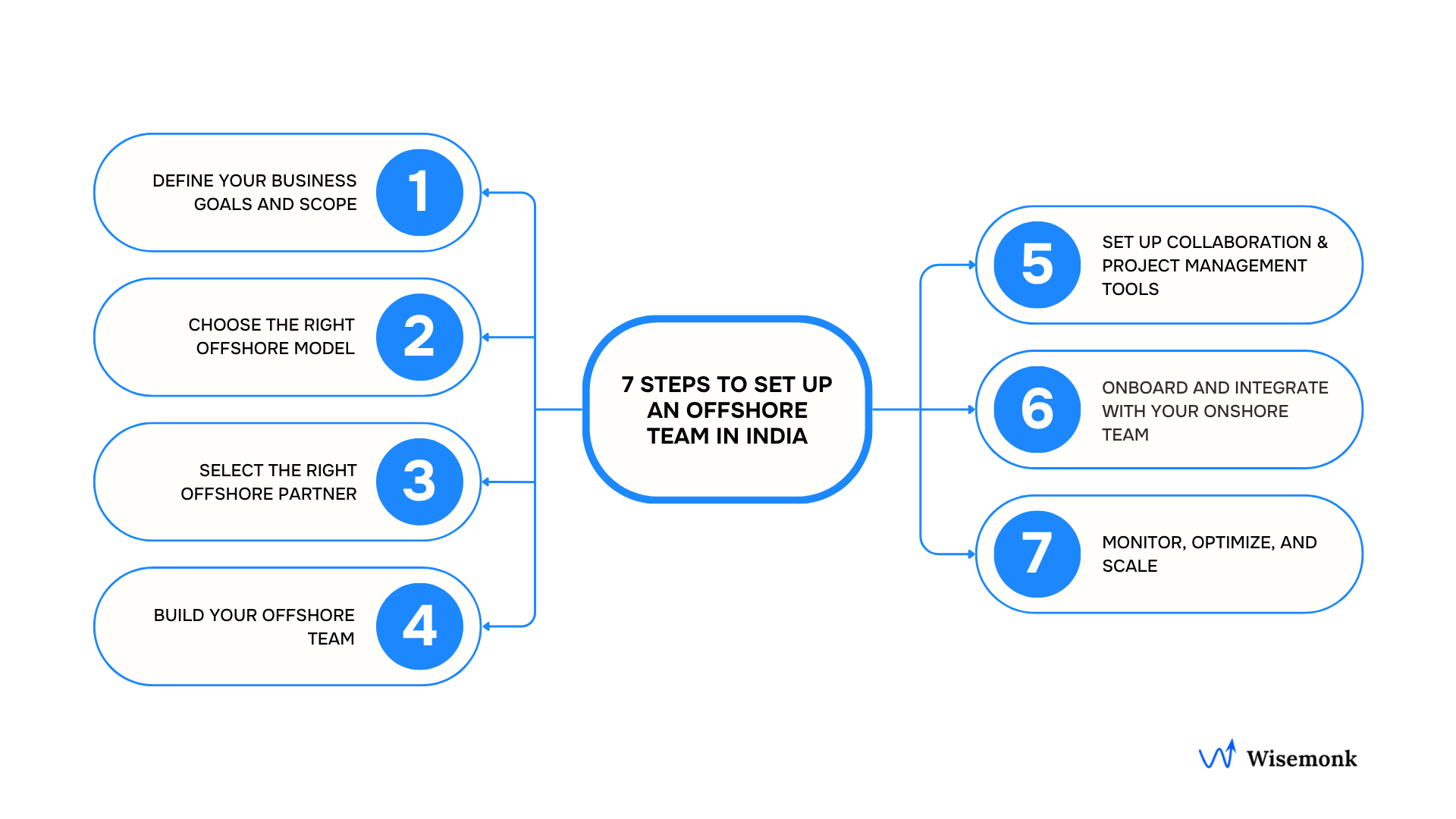
Step 1: Define your business goals and scope
- Clarify what you want your offshore team to achieve, whether it’s software development, IT support, or handling business processes.
- Decide on the team size, skills required, and project timelines.
Step 2: Choose the right offshore model
- Pick between a dedicated offshore development team, offshore development center, or a project-based outsourcing model (covered in Section 2).
- Consider cost efficiency, scalability, and how much control you want.
Step 3: Select the right offshore partner
- Work with a reliable offshore development company that understands compliance, security, and industry-specific needs.
- Look for experience in managing offshore development teams and ensuring seamless collaboration across borders.
Step 4: Build your offshore team
- Recruit skilled developers, project managers, and future team members through your partner or direct hiring.
- Ensure stringent security protocols are in place to protect your data and business processes.
Step 5: Set up collaboration & project management tools
- Use reliable communication tools: Slack or Microsoft Teams for instant chats and video calls.
- Establish ground rules: Define response times, escalation paths, and reporting structure to avoid communication gaps.
- Leverage project management platforms: Jira, Asana, or Trello to track tasks, sprints, and delivery timelines.
- Bridge time zones with overlap hours: Set 2–3 hours of real-time collaboration where offshore and onshore teams can sync.
- Address cultural differences early: Train teams on cross-cultural awareness and encourage informal interactions to build trust.
- Share company goals, not just tasks: Transparency builds motivation and helps offshore teams feel part of the bigger mission.
Step 6: Onboard and integrate with your onshore team
- Introduce your offshore team members to your company culture, business goals, and project management practices.
- Invest in team building activities and communication tools to ensure mutual understanding and effective collaboration.
Step 7: Monitor, optimize, and scale
- Regularly review performance, manage communication gaps, and address cultural differences.
- As your offshore team proves successful, expand into a dedicated development team or offshore development center to scale operations.
💡 Expert Insight: Companies that follow a structured offshore setup process report up to 30% faster project timelines and better outcomes compared to ad-hoc outsourcing (PwC Global Sourcing Report, 2024).
What legal, tax, and compliance issues should you watch out for?[toc=Legal & Compliance]
When you set up an offshore team in India, compliance is not optional. To avoid penalties, lawsuits, or permanent establishment (PE) risks, global businesses must ensure their offshore team follows Indian labor laws, payroll rules, and tax obligations from day one.
Here are the key compliance areas you should be aware of:
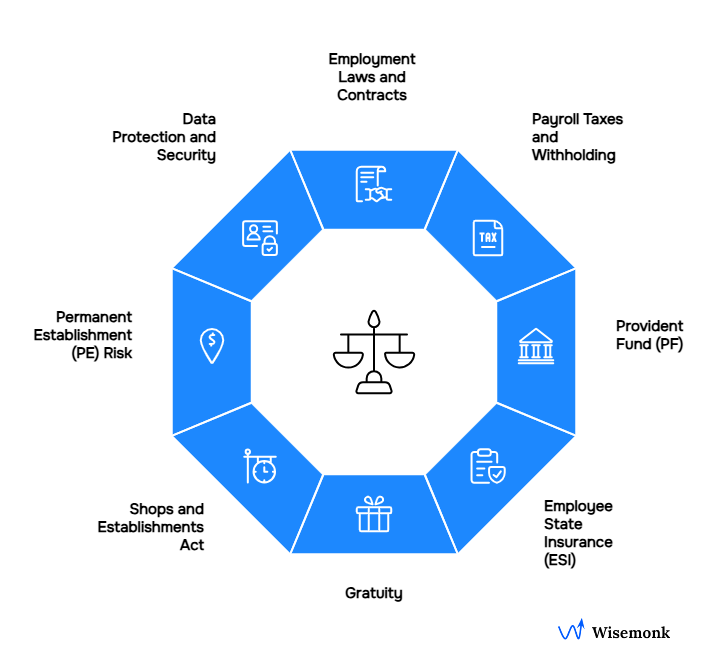
1. Employment Laws and Contracts
Every offshore team member needs a valid employment contract that aligns with Indian labor laws. This should cover job roles, salary, termination clauses, and statutory benefits. Without compliant contracts, companies risk disputes and non-compliance fines.
2. Payroll Taxes and Withholding
Employers must deduct income tax (TDS) from salaries and remit it to the government. This is a critical part of payroll compliance in India. Non-compliance can lead to penalties and interest charges.
3. Employees' Provident Fund (EPF)
EPF is mandatory for most employees in India. Employers contribute 12 percent of basic wages, matched by the employee, to a retirement savings fund. If your offshore team is on your payroll, PF compliance is non-negotiable.
4. Employee State Insurance (ESI)
For employees earning below a certain salary threshold, companies must contribute toward medical and social security through ESI. This provides health insurance benefits and is a key part of statutory compliance.
5. Gratuity
Employees who complete five years of continuous service are entitled to gratuity. It is a lump sum paid at the time of exit or retirement. Offshore companies must account for this liability if building long-term dedicated teams in India.
6. Shops and Establishments Act
Every offshore development center or office must register under the state-specific Shops and Establishments Act. This regulates working hours, leave policies, and working conditions for your offshore software development team.
7. Permanent Establishment (PE) Risk
If your offshore operations are structured incorrectly, your company may be considered a taxable entity in India. This can expose you to corporate tax liabilities. Partnering with an Employer of Record (EOR) or offshore development company helps avoid PE risk.
8. Data Protection and Security
Global clients often require compliance with GDPR, HIPAA, or other international security frameworks. Your offshore partner should have stringent security protocols to safeguard sensitive business processes and client data.
💡 Expert Insight: According to EY, over 40 percent of global companies expanding into India face compliance challenges due to PF, ESI, and labor law complexities. Having a local compliance expert or offshore partner can help avoid costly mistakes.
How can you recruit and retain top talent in India?[toc=Recruiting Top Talent]
To build your offshore team in India successfully, you need to attract skilled developers and keep them motivated for the long haul. Recruitment is about more than posting jobs; it’s about tapping into the right channels and creating a work culture that makes your offshore team members want to stay.
1. Use Proven Recruitment Channels
- Job Portals: Platforms like Naukri.com, Indeed India, and LinkedIn are leading sources for software development and project management roles.
- Talent Networks: Many offshore development companies have pre-vetted pools of skilled developers ready to join dedicated offshore development teams.
- Specialized Recruiters: Partnering with local agencies or EOR providers helps you find niche talent faster, especially for technical development projects.
2. Offer Competitive Compensation
Salary expectations in India vary by role and city. For example:
- Software developers with 3–5 years of experience earn an average of INR 8–15 lakhs per year (approx. USD 10K–18K).
- Senior developers and project managers can command INR 20–35 lakhs per year (USD 24K–42K).
Offering competitive pay aligned with market standards ensures you attract top talent from the global talent pool.
3. Provide Clear Career Growth
Retention is easier when offshore team members see a future. Offer:
- Training and development programs
- Opportunities to lead parts of the development process
- Performance-based promotions and salary hikes
4. Build a Strong Company Culture
Your offshore team in India should feel like an extension of your onshore team. Use collaboration tools like Slack or Microsoft Teams to integrate daily workflows and encourage seamless collaboration.
- Regular team building activities (both virtual and in-person)
- Open communication to avoid communication gaps
- Recognition programs to keep the team motivated
5. Focus on Retention Levers
- Offer flexible work arrangements for remote teams
- Provide health insurance and retirement benefits (through PF and gratuity)
- Maintain transparent communication around business goals and project timelines
How can you scale and optimize your offshore team over time?[toc=Scaling Your Offshore Team]
Once your offshore team in India is established, the next challenge is scaling it without losing efficiency. Scaling is not just about adding more offshore developers, it’s about optimizing processes, maintaining culture, and ensuring cost effectiveness while supporting your business goals.
1. Standardize Processes Early
- Document workflows, coding standards, and business processes.
- Use project management software like Jira or Asana to create repeatable systems for new offshore team members.
- This minimizes technical debt and accelerates onboarding of future team members.
2. Build Leadership Within the Offshore Team
- Promote experienced offshore developers into lead roles or project managers.
- Local leadership reduces reliance on onshore managers and helps in successful offshore team management.
- Leaders on the ground ensure quicker decisions and smoother collaboration.
3. Optimize Communication Structure
- As your dedicated development team grows, avoid overwhelming the onshore team with direct communication.
- Create pods or sub-teams managed by project managers to streamline updates.
- This ensures project progress remains clear and organized even with larger offshore development teams.
4. Invest in Training and Development
- Upskill your offshore software development team with regular training in new technologies.
- Provide access to global certifications and learning resources.
- Skilled developers who grow with your company are more likely to stay long-term.
5. Monitor KPIs and Performance Metrics
- Track delivery timelines, code quality, and cost efficiency with measurable KPIs.
- Use project management platforms to generate performance reports and identify areas for optimization.
- Regular reviews help keep your offshore team motivated and aligned with company goals.
6. Expand Gradually with a Strategic Plan
- Don’t scale too fast without ensuring collaboration tools, security, and compliance are ready.
- Consider transitioning from a dedicated offshore development team to a full offshore development center if your growth requires larger teams and more infrastructure.
- Partnering with the right offshore development company can make scaling smoother.
Scaling a remote offshore team is about building systems, empowering local leaders, and tracking performance. With the right strategy, you can expand seamlessly while keeping your offshore team efficient, motivated, and aligned with your business goals.
How does Wisemonk help in building your offshore team in India?[toc=How Wisemonk helps]
Wisemonk is a leading Employer of Record (EOR) service provider in India, dedicated to helping global businesses smoothly build & manage their offshore teams. Our expertise lies in simplifying the complexities of offshore team setup, ensuring smooth compliance with local labor laws, and providing reliable support so you can focus on driving your software development projects and business goals.
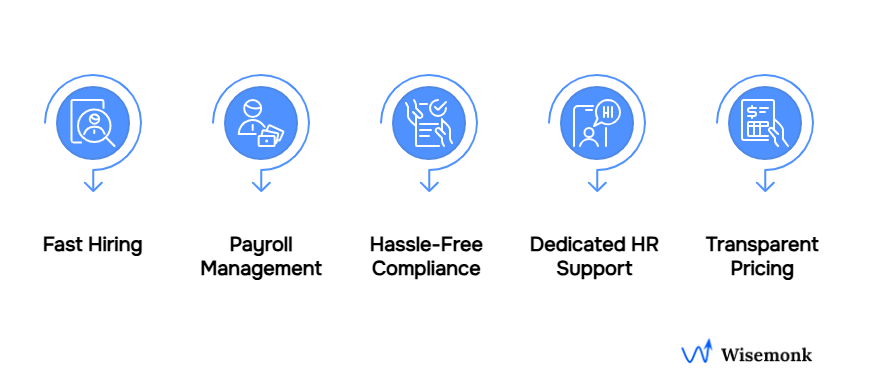
Key Features of Wisemonk:
- Streamlined Hiring Process: Our extensive network accelerates talent acquisition, helping you quickly build a dedicated offshore development team.
- Robust Payroll Management: We take care of accurate and timely salary processing, taxes, and benefits administration.
- Hassle-Free Compliance: We handle all legal, payroll, and statutory compliance requirements, ensuring your offshore team in India operates within the regulatory framework.
- Dedicated HR Support: Our team provides ongoing assistance for operational, HR, and employee engagement needs to keep your offshore team motivated and productive.
- Transparent Pricing: With clear, competitive pricing, you get a cost-effective solution for offshore team management without hidden fees.
Beyond core EOR services, we also offer comprehensive solutions, including HR outsourcing, company registration, background verification checks, Global Capability Center (GCC) setup, and global expansion support, making us your trusted partner for scaling your workforce internationally with confidence and ease.
With Wisemonk, you don’t just hire offshore developers — you get a trusted India-native partner who takes care of compliance, payroll, and people management, letting you focus entirely on business growth and project success. Contact us today!




.png)
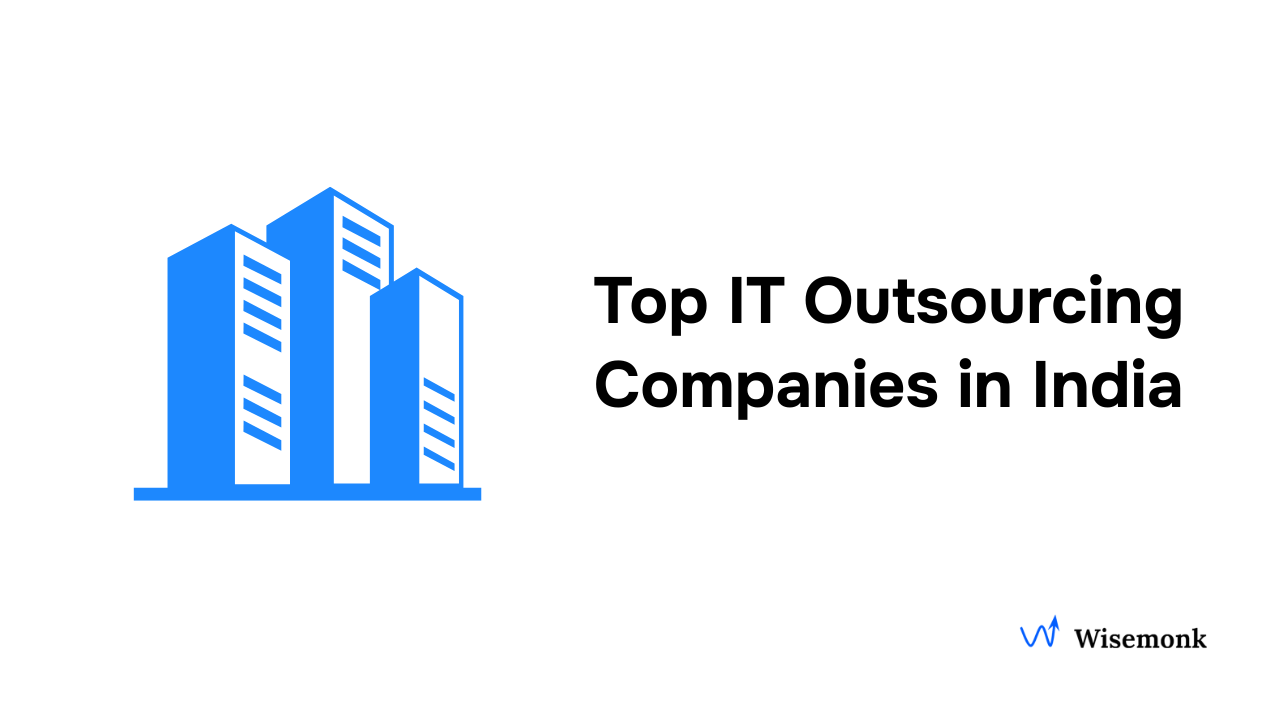
.webp)